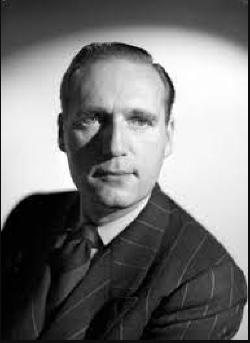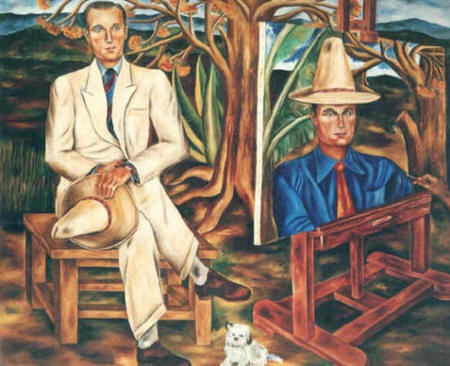

Queer Places:
Av. Paseo de la Reforma 260, Juárez, Cuauhtémoc, 06600 Juárez, CDMX
 Henri
Hutchinson aka Henri de Châtillon (England, 1906 - Mexico City, Mexico, 1972) was a French-British fashion designer and hatter based in Mexico.
Mexico City attracted international gay visitors between the 1940s and 1960s,
with its cultural life, low cost of living, the intelligentsia’s leftist
orientation, and the city’s architectural beauty. Political, cultural and
sexual dissidents found the fast-growing city welcoming despite its rapid
population growth: from 1.5 to 6 million between 1930 and 1960. Successful upper-middle-class gay professionals purchased or custom built
detached homes in the best residential neighbourhoods, too. This small elite
consisted of actors, executives, upper-level government functionaries,
artistic entrepreneurs and professionals – among them
Elías Nandino, fashionista
Henri de Châtillon, painter
Roberto Montenegro and
decorator Arturo Pani. In the
1940s, decorator Henri de Châtillon organised his annual fashion show at his
glamorous home on Paseo de la Reforma (where he also maintained his atelier),
and in late 1946, Arturo Pani lived above his home decorating studio at the
corner of Niza and Hamburgo.
Henri
Hutchinson aka Henri de Châtillon (England, 1906 - Mexico City, Mexico, 1972) was a French-British fashion designer and hatter based in Mexico.
Mexico City attracted international gay visitors between the 1940s and 1960s,
with its cultural life, low cost of living, the intelligentsia’s leftist
orientation, and the city’s architectural beauty. Political, cultural and
sexual dissidents found the fast-growing city welcoming despite its rapid
population growth: from 1.5 to 6 million between 1930 and 1960. Successful upper-middle-class gay professionals purchased or custom built
detached homes in the best residential neighbourhoods, too. This small elite
consisted of actors, executives, upper-level government functionaries,
artistic entrepreneurs and professionals – among them
Elías Nandino, fashionista
Henri de Châtillon, painter
Roberto Montenegro and
decorator Arturo Pani. In the
1940s, decorator Henri de Châtillon organised his annual fashion show at his
glamorous home on Paseo de la Reforma (where he also maintained his atelier),
and in late 1946, Arturo Pani lived above his home decorating studio at the
corner of Niza and Hamburgo.
Henri Hutchinson was born in England to a French mother and a Scottish father; his mother settled in France shortly before the First World War and has her other son André Ledoux, the result of his second marriage, in Paris in 1909. From that moment very little is known of Henri's life until 1936, the year in which after succeeding as a designer in Paris and buying a rural property in Jouy-en-Josas, he adopted the pseudonym Henri Hutchinson de Châtillon because every time he left Paris he did it through the Porte de Châtillon (gate of Châtillon); until in the 1940s, after his arrival in Mexico, he dispensed with his real surname to be known only as Henri de Châtillon.
After World War II Châtillon left for Canada with the plan to settle in South America, passing through New York and then through Mexico, where he resided for the rest of his life. His first known work as a designer is the costumes he creates for the play Helena of Troy that the American Ballet Theatre presented at the Palace of Fine Arts and the Metropolitan Opera in New York in 1942. He was quite successful as a designer, by 1949 he already had a business of one million pesos on Reforma Street and Time magazine covered its annual parade describing the unpunctuality of Mexican clients and the prices of their dresses; among his clients were Marga López, Dolores del Río and María Félix who even mentions it in her autobiography "Todos mis guerras" and describes that only some exclusive stores in Mexico besides her own store sold Châtillon dresses. Although some of his hats were made from Mexican materials such as zacate and tortilla and most of his dresses were made of national materials, his design style was still European.
Il Milliner, Portrait of Henri de Châtillon, by Diego Rivera, 1944

Artist: María Izquierdo (Mexican, b. ca. 1906–1955), Title: Retrato de
turista (Retrato de Henri de Chatillon) , 1940
In 1940 the producer Álvaro Gálvez y Fuentes, together with the journalists Rosario Sansores and Pedro de Lille summoned Ramón Valdiosera, Armando Valdés Peza and Henri de Châtillon to the radio program Lunas Verdes to debate if the existence of a Mexican fashion was possible, an issue that both Valdés Peza and Châtillon denied, the debate was resumed years later and in an interview with the magazine Nosotros he declared: "Mexico is very backward, there are no materials, fabrics are useless and you could not compete with the European or less with the North American ... To be fashion there must be elegance and the Mexican woman cannot be elegant, because she has many buttocks." Statements that would damage his image and earn him the repudiation of most Mexican media for commenting on the bodies of women in the country; however, it is disputed that he was against the existence of a Mexican fashion, because after all he innovated using national materials such as tortillas to make his hats and contributed to the existence and promotion of a Mexican fashion of author, even declared later for the Milwaukee Journal "here in Mexico my sense of color has improved".
By the end of the 1960s his business was declining, moving to a hotel called Río Amazonas in the Cuauhtémoc neighborhood; with the rise of the aeronaval industry it was easier for his clients to fly to Miami and buy clothes there than in his boutique, finally, he died on May 23, 1972 in Mexico City as a result of the aftermath of a hemiplegia he suffered a few years earlier.
The first record of his presence in Mexico is the painting "Portrait of a Tourist" by María Izquierdo (1940). Although she has nowhere specified that Châtillon is the one portrayed, Octavio Paz mentions both Henri and the work in the letters he writes to Octavio Barreda years later; in 1944 Diego Rivera portrayed Châtillon and titled the painting "Il Milliner (The Hatter)"; according to critic Gustavo Prado, the painting is unflattering and is likely to be commissioned by some wealthy client of the designer rather than a work by the muralist.
My published books: